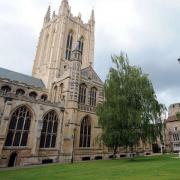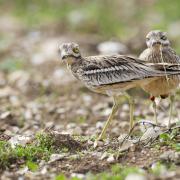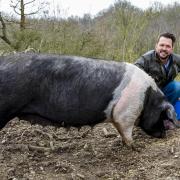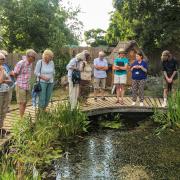Dunwich Heath is one of the jewels in Suffolk’s crown. Designated a Special Site of Scientific Interest, the coastal reserve is packed with interesting wildlife, plants and trees. It is especially known for the glorious mantle of purple heather that covers it each summer, a wonderful sight with the North Sea as a stunning backdrop.
Imagine if that were to change. Rare nature reserves such as this need constant management to conserve habitats and help species thrive, and the effects of climate change are making this challenge even tougher.
A dedicated team of National Trust staff and volunteers have been exploring innovative projects and methods to mitigate these effects and the results are promising.

Sam Cooper, area ranger at Dunwich, says the dry weather spell more than two years ago had a damaging impact on the site’s famous heather. The drought in 2022 destroyed more than half of it, so the team have been looking at ways to encourage regrowth.
'We commissioned an infrared drone survey to see a map of whole heathland and show where there was live and dead heather,' he explains. 'We found that 60 per cent of it had died off in the drought. We used the survey to help form decisions on how to restore the heather.' Last winter, for example, they focused on more management in those areas where it had died off.
The heather’s deterioration doesn’t just have an impact on the aesthetics of the heath, it also affects the wildlife. Certain insects feed on the heather; in turn, those insects are food for breeding Dartford warblers.

'We know that less warblers nested here last year and a big part of that is because of the reduction in heather,' says Sam. 'The current theory is that high tree cover helps protect heather as it offers more shade so we are exploring ideas of heather recovery.'
The team employ a technique called mosaic cutting; it means there are different ages of heather across the heath so it won’t all reach the end of its life at the same time. This also helps the ecology, as different habitats and species thrive on varying ages of the plant; for example, Dartford Warblers nest in mature heather, and reptiles and insects prefer bare soil once the heather has been cleared.
For Sam, Dunwich has been a part of his life since he was a young child, and it was a work experience placement at the reserve when he was 14 that first ignited his passion. He went on to do a course in countryside management, which included two days a week volunteering at Dunwich. After a spell at Orford Ness, he landed the job as area ranger at Dunwich a year ago.

'I used to go for family walks in Dunwich when I was little and remember getting a jacket potato from the café,' he says. 'I did my work experience there and loved it. I couldn’t believe all the wildlife that was present and enjoyed seeing how things worked. I loved the practical aspects of my work experience, like searching for otter spraint and capturing video footage of them.'
That energy and love for the heathland hasn’t dampened over the years. Sam enjoys the variety of the job, from carrying out land management tasks for part of the year, to seeing the results of this work through the ecological surveys.
Among the challenges of the role is adjusting ways of managing the heath to cope with adverse weather conditions. It’s not just the heather that has been affected; other habitats at Dunwich have also been impacted. The younger trees in the woodland cannot cope with lack of rainfall as much as the mature trees, as they don’t have the root depth.

Warmer winters mean burrowing insects and fungi are not reducing, which can damage or kill trees. Changing weather patterns and strong tides can also affect the cliffs, which are currently protected by the shingle beach.
'All the work we do has a positive impact on the following year,' says Sam. 'The heather is already in a better position now- the wet summer helped and we have more tree cover which provides shade.'
Since the National Trust took over the site in 1968, teams have been working to replace lost habitat and restore areas for rare breeding birds. This has clearly paid off as Dunwich Heath became the first site in East Anglia to record breeding Dartford warblers, after an absence of almost 60 years. Around 35 pairs of these elusive birds are now resident all year round.

'We have a very high density of Dartford warblers; this is the best place in the country to see them,' says Sam. Another major success in recent years has been the first successful breeding of stone curlews, while other rare wildlife that has made a home at Dunwich includes water voles, red deer, nightjars and antlions.
'Dunwich Heath has a really high nature value, so it’s about keeping it at optimal value,' says Sam. This precious landscape, loved by both nature and people, is one of the most important conservation areas in Suffolk, which is why it is so vital we help protect it.

The rich history of Dunwich Heath
Dunwich was once a thriving medieval port, on a par with London as the capital of the kingdom of East Anglia, with over 3,000 residents recorded in 1086. However, the effects of storm surges and the resulting coastal erosion washed away much of the harbour buildings and land.
During the Second World War, Dunwich Heath was a militarised zone and one of the most heavily defended parts of Suffolk. After the war, the heath was handed back to its owners, Dunwich Town Trust, and it became a popular tourist destination.
By 1968, there were concerns that unregulated camping was having a negative impact on the fragile landscape and, as Dunwich Town Trust did not want to turn it into a campsite, it was sold to the National Trust.
The soil that makes up the slopes of the former Dunwich Common is mainly sand, which forms lowland heath. This type of heath used to be prevalent across England but has declined by 92 per cent in the last 120 years. Dunwich Heath is one of the very few habitats of its kind left, which means it can support the many rare wildlife and plant species that rely on this kind of ecology.

Visit Dunwich Heath
There are lots of activities to do at Dunwich Heath, from a Smugglers Trail for families and geocaching, to seasonal guided walks and bird watching activities. There is also a café, toilets, second hand bookshop and car park on site. Visit nationaltrust.org.uk/visit/suffolk/dunwich-heath-and-beach



























